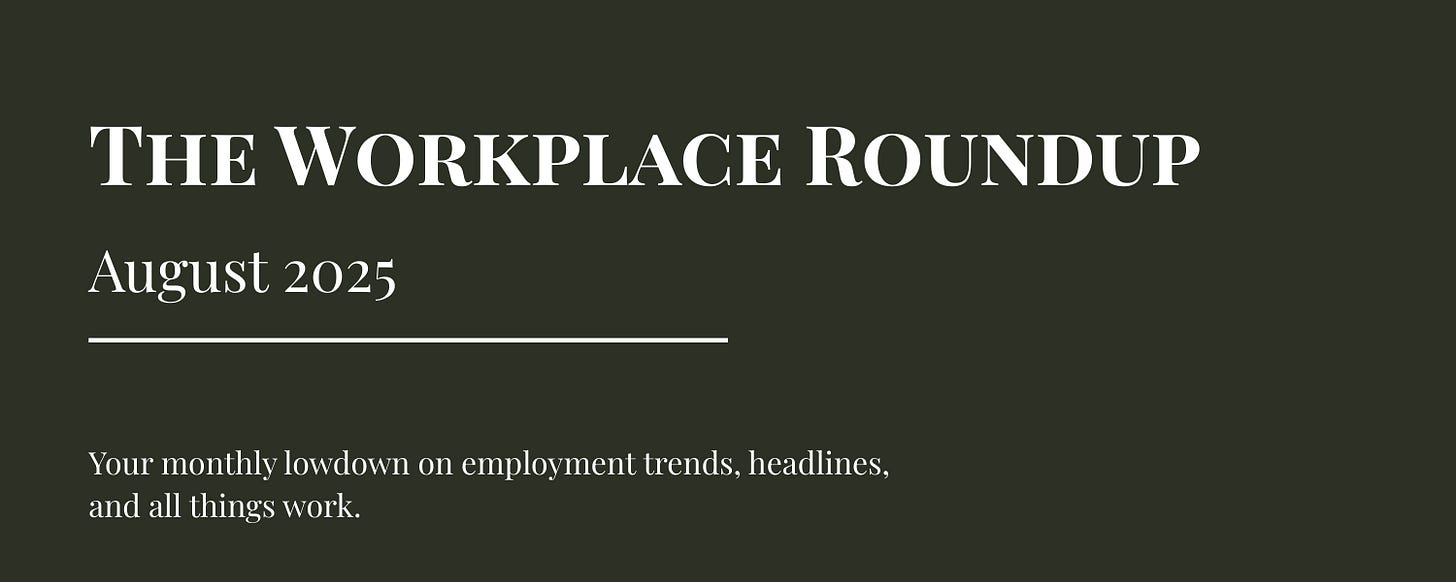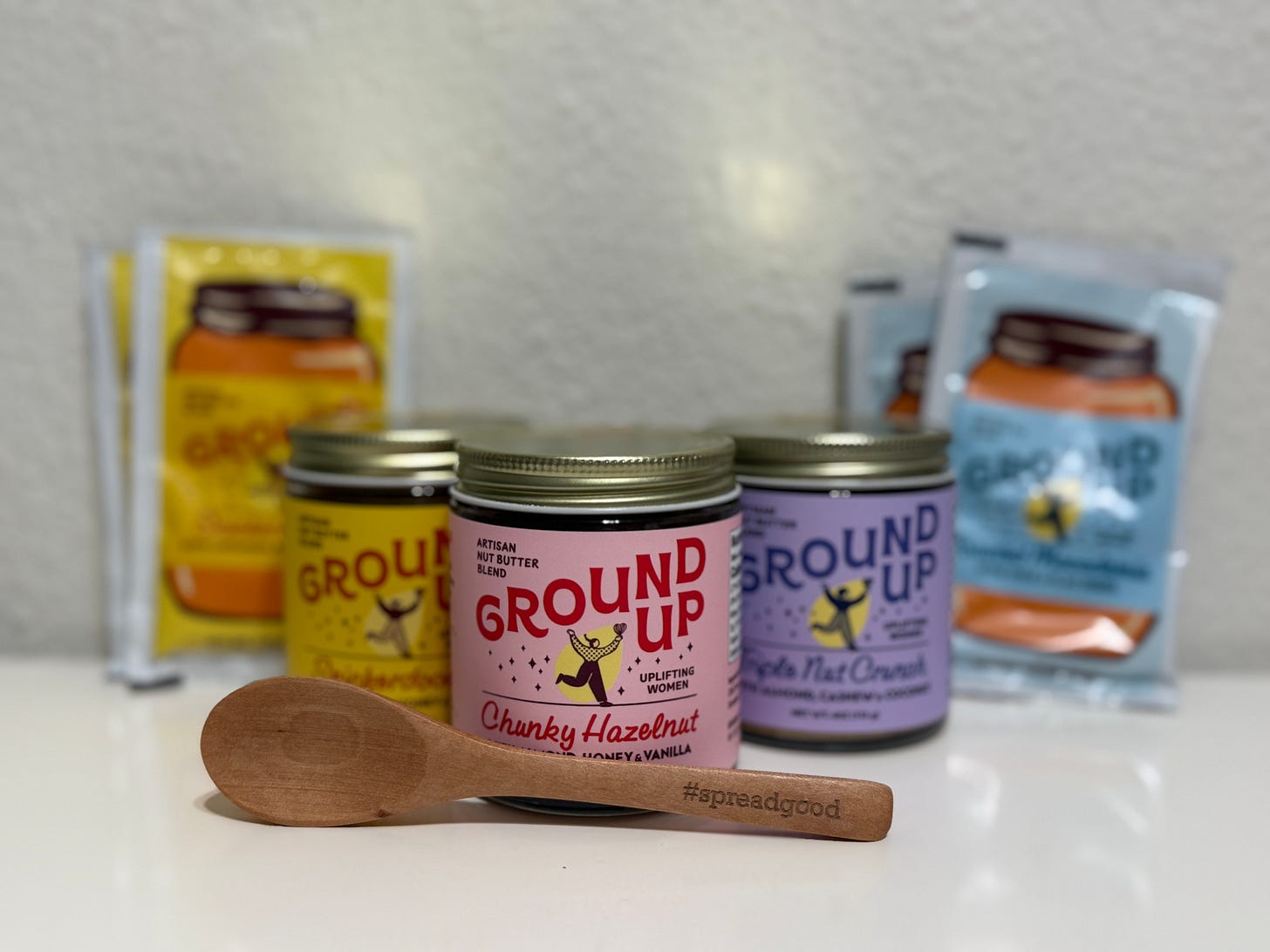The Workplace Roundup: August 2025
New job postings dip, women in sports rise, and return-to-office mandates spark employee pushback.
US Workforce Trends 💼
Job-changers experiencing higher payoffs than job-stayers
In July, ADP Research reported that job-stayers gained a 4.4% increase in salary year-over-year (July 2024-July 2025) and job-changers experienced a 7% increase in salary.
This aligns with another trend I’ve noticed - the elimination of entry-level positions. Many companies take a “poaching” approach to staffing—offering no entry-level roles, little chance for advancement, and minimal training. Instead, they hire workers from other companies that did provide entry-level opportunities and invest in development. Then they offer the poached employee a 7% pay increase from what they were making before.
You can’t blame people for following the money, we all operate in our own best interests in the workforce. But this model of poaching, as entry-level jobs become harder to find, is unsustainable. It’s like a collapsing bridge, with management destroying the path behind them by eliminating entry-level positions and replacing them with technology or outsourcing.
There’s more to dissect here, so keep an eye out for a piece I’m working that will deep dive into the current and future state of entry-level positions.
Do as I say, not as (A)I do
The popular HR hiring platform Workday is facing a collective action lawsuit in California for the use of its AI-based applicant recommendation software. ✨Allegedly✨ the software negatively affected candidates aged 40 and up in the hiring process. Now the lawsuit is asking Workday to provide a list of all the customers who enabled the AI feature - HiredScore.
It’s concerning that so many companies and platforms are using AI to sort their candidates, especially when it’s a well-known problem that AI can be biased because of the data it’s trained on. Ageism is rampant in hiring, so it is not hard to connect that AI is trained on ageist data. I understand needing to use tools to help sort through applicant pools that are 100+, but the results should be audited.
In New York, AI use in hiring has been restricted and results need to be audited, and candidates must be notified of the use of it. This seems like a good model other states could adopt. Just let the candidates know!
On the other hand, employers are also seeing a significant increase in AI-generated job applications. Resume tailoring has become easier with tools like ChatGPT, especially as applicants recognize the value of weaving key job description terms into their resumes. Applying for jobs has started to feel like a rigged game, and now some employers are becoming frustrated that applicants are using tools to boost their chances. Recruiters say many applications are beginning to look alike, making it difficult for them to assess individual candidates.
Is anyone surprised we’ve reached this point? Employers have become stringent in how they filter and hire applicants, so job seekers adapted. Employers are using AI to filter applications, and applicants are using AI to fill out job applications. Some companies, like Anthropic - an AI tech company, are discouraging applicants from using large language models (LLMs) to help with their application materials. They think they want authenticity, but their own AI applicant software will likely pick the candidates who used AI anyway. Like calls to like ✨
Ohhhhhh, the irony.
If I were an employer, I would ask applicants to hand deliver their applications, then you’d really learn who wants the job.
Job numbers lower than originally reported
If you missed it, the Bureau of Labor Statistics released updated numbers for prior data they had released, and it does not look good. Originally, new job openings for May and June were reported at 125,000 and 147,000 respectively, but revisions now show that only 19,000 and 14,000 jobs were added. 73,000 jobs were added in July, but we’ll learn next month if those numbers are lower now too.
Hiring typically slows in the summer months, with fall demonstrating an uptick in hiring, so we’ll see if these trends continue into the fall months. People are owing the slow down in job creation to the chaotic trade-policy negotiations. Job creation has been slowing down since 2022, but these numbers are new lows. Trump fired the head of the BLS because of the revised job numbers, saying they were politically skewed. Tough job market to get fired in…
If you or someone you know has been facing difficulty job hunting, consider sharing New Ropes with them!
🔦Career Spotlight🔦
Registered Nurse (RN) Practitioners
This role is expected to grow by 46% between 2023 and 2033. The healthcare industry is experiencing a major worker shortage, due to an aging population and retiring workforce, and nurses are at the top of their demands. Though it is challenging work, this career path offers job stability, work environment flexibility, and deep meaning through positively impacting patient’s lives.
Becoming a Registered Nurse: You will need to complete an accredited nursing program, either an Associate Degree in Nursing (ADN) or a Bachelor of Science in Nursing (BSN), pass the NCLEX-RN exam, and obtain state licensure. While obtaining a BSN will offer higher earnings and more career paths, both degrees will help you begin your career as an RN.
Global Scope 🌍
Women’s sports are on the up 📈
Women’s football (⚽️) is booming globally, and nearly all women’s sports are beginning to see money flow in as interest grows in them. Forecasts are even predicting that revenue from women’s professional sports will jump to $2.4bn in 2025, from $695m in 2022.
FIFA is aiming to double the number of women playing organized football around the world to 60m by 2027, and the International Cricket Council is hoping to bring in 250m incremental fans to the women’s game through its new campaign. The pay gap between male and female athletes is still stark (men’s football’s biggest earner making $232m in 2024; women’s biggest earner making about $1m), but with increased interest and investments in women’s sports, we’re beginning to see this gap close, ever so slowly.
Work Wins, Woes, & Whoas
Work Wins 🏆
Not all companies look to poach their talent, some value building up their talented workforce, and companies like Guild are helping them do it. Guild is a firm which primarily serves larger companies and offers resources for up-skilling and education. Through them, companies can provide their employees opportunities for leadership training, credentialed education, and other perks. Offering opportunities like these to employees leads to better recruitment, retention, and internal mobility.
Many companies are opting into competitive models that prioritize employee wellbeing and retention efforts. According to the Society for Human Resource Management, nearly half of public and private employers have a tuition reimbursement program for employees, and about 8% of employers offer help paying off student loans. These programs are not always easy to find out about, so make sure to check with your current employer’s HR rep to see what they might offer.
Additionally, on August 11th the US Dept. of Labor announced the availability of $30M in grant funding to accelerate innovation and address workforce needs. The grants will provide outcome-based reimbursements to employers for providing training and up-skilling in high-demand and emerging industries, such as AI infrastructure, advanced manufacturing, nuclear energy, domestic mineral production, and information technology.
Yay for workforce investments!
Work Woes 📉
Consulting firms are beginning to feel the heat of shifting markets. Over 2,800 government contracts were canceled with consulting firms, as of June, by DOGE and the GSA, in order to cut federal spending. And while firms are hoping to offer consulting services to companies to help with AI integration, many companies are implementing AI on their own to provide analyses rather than turning to consultants.
The loss of government work and the integration of AI by clients (and internally) have lead to firm downsizing. Consulting firms like McKinsey, Deloitte, and Booz Allen are beginning to announce or initiate layoffs. It’s tough to tell what consulting will look like 10 years from now. It definitely won’t die, but it will need to make fundamental changes.
Work Whoas 🚨
Companies are beginning to pull back on their earlier enthusiasm about hybrid/remote work, and employees are not happy. Some big names like Amazon, Apple, Goldman Sachs, and Google, amongst many others, are rolling out new "Return to Office” (RTO) policies, requiring anywhere from 3-5 days in office per week. They do this in the name of collaboration and company culture, but it could be more hurtful than helpful.
Gallup data from 2024 shows that workers who worked in-office when they could perform the work remotely have shown the steepest drop in workplace engagement. Data from an Owl Lab survey reported that 66% of people surveyed are actively looking for new roles due to RTO policies. And so the battle continues.
Personal Developments 🌱
🎧What I’m listening to: The Diary of a CEO with Steven Bartlett - This popular podcast series focuses on sharing the stories of the world’s most fascinating CEOs, experts, therapists, and leaders. I love combing through and finding episodes about people or industries I’m interested in.
📚 What I’m reading: Unsettled: What Climate Science Tells Us, What It Doesn’t, and Why It Matters by Steven E. Koonin - I saw this book recommended online by former climate activist professionals who had left the industry, and I had to read it for myself. I have not finished it yet, but it has been captivating and challenging of assumptions, especially with all the competing science we hear thrown around in the media.
🍿 What I’m snacking on: GroundUp Nut Butters, founded in Portland in 2016, makes delicious nut butters while offering women overcoming adversity a second chance at employment. Through their sales, they offer a 6–9 month training program that builds job skills and confidence.
I love how this not-just-for-profit model blends business success with community impact—proving profit and purpose can go hand in hand. Everyone deserves a chance to work, regardless of their past.
Reader Survey
In Case You Missed It ⤵️
Learning the Ropes: Distilling Whiskey with New Basin Distilling Company
In this episode of “Learning the Ropes” I join distillery owner Rick Molitor in Madras, Oregon to learn about how he got into the spirits industry, what it’s like owning and running a distillery, how to make whiskey and other liquors, and more.
At the beginning of August I started a video series on my other media channels called “If I got laid off tomorrow…” where every day for the month of August I’m sharing low-barrier, but high-potential careers people should consider if they’ve been laid off. Click any of the links below to check out the series:









Grace, this roundup hits on the pulse of what’s really driving tension in today’s workplace 👏 Let me just add that RTO mandates framed as “culture” too often miss the point—real culture isn’t about location, it’s about trust, clarity, and how leadership shows up when the market shifts.